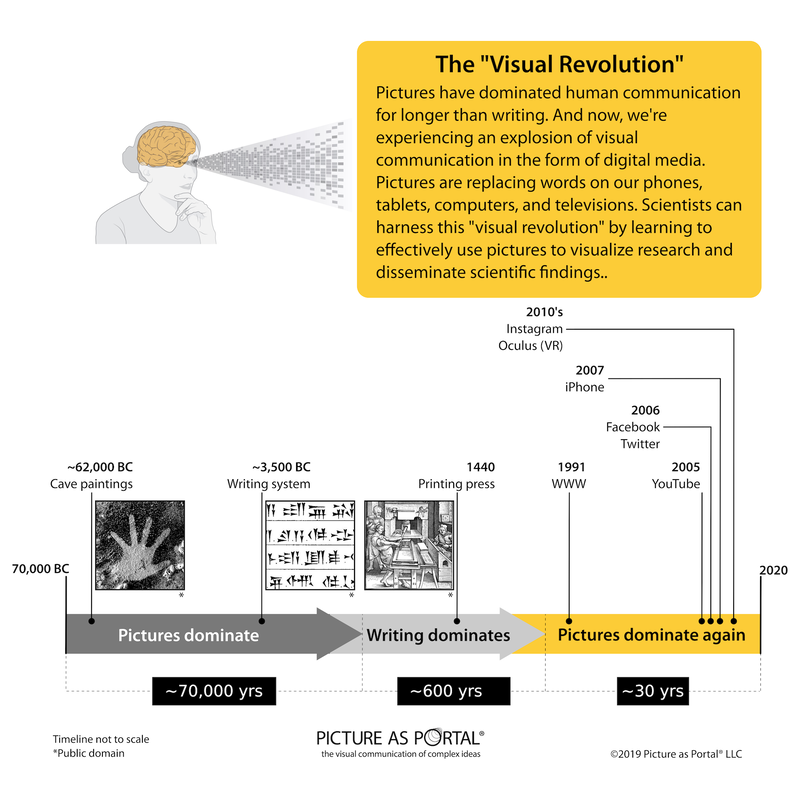This post was contributed by Picture as Portal® cofounder, Betsy Palay. Betsy is a Certified Medical Illustrator and science communicator. She is a founder, former president, and previous creative director of Artemis Creative, Inc. She was president of the Association of Medical Illustrators from 2009 – 2010.
Around 1440, Johannes Gutenberg invented the printing press and changed the world. Words—and thus information and ideas—could now be easily duplicated and distributed by the thousands. Printing technology caused a literacy revolution around the globe.
We’re now in the midst of another revolution—not of words, but of pictures. It’s been said that “the digital revolution is a visual revolution.” (1) I agree. Ironically, digital technology is now making it possible for humans to return to our original—and in many cases our best—form of communication: the picture.
Check out this timeline. Humans communicated through pictures for about 70,000 years before somebody devised a way to put spoken words into a visible form through written language.

No question about it, written language is very useful. However, translating our thoughts into words that can be written and read is tedious and indirect. It requires two sequential steps: the translation of thoughts into words by the thinker, and then the translation of words into thoughts by the reader.
The advantages of visual communication
Pictures, on the other hand, offer communication with no translation necessary. Pictures actually mirror physical, spatial qualities of the real world. Imagine looking at a map. In an instant, you immediately understand what’s far, what’s close, and what barriers stand between you and your destination.
Even more important, the way we organize objects in the physical world—into groups and subgroups for example—mimics the way we organize conceptual information in our brains. So we can instantly see concepts when we look at a picture —no translation necessary. Imagine a calendar or an organizational chart. You instantly know how far away your birthday is. Or which departments have the most influence in your organization.
From the point of view of biology, this makes a lot of sense. The brains we use today evolved about two hundred thousand years ago—long before written words existed. At that point, what we needed were brains that could navigate a complex 3-dimensional world and make instantaneous decisions about what to run from and what to run toward. We needed brains that could very quickly process complex shapes, sizes, colors, edges, and other visual elements of our natural surroundings. And we got them! It’s estimated that in a quarter of a second, our human brains can analyze 30 different characteristics of visual input. To perform this feat, more than a third of our brains are devoted exclusively to the processing of visual input entering our eyes. (2)
On the other hand, it’s pretty certain that written language is at most only several thousand years old. This means that in order for us to read, we’ve had to adapt the brains and neural systems we already have (3) The fact that we can read at all is a testament to the adaptability of our brains. But it’s still a Rube Goldberg construction.
In order for us to read, we’ve had to adapt the brains and neural systems we already have (3) The fact that we can read at all is a testament to the adaptability of our brains. But it’s still a Rube Goldberg construction.
| Visual communication has other advantages. Unlike words, pictures are non-linear. They’re great at showing us relationships between things—especially ideas and information—by enabling us to see all the content simultaneously. This is a huge advantage. In verbal language, by the time we read or hear the last word of a paragraph, the first word is long gone. In a picture—like in our maps—we can see the starting point and the ending point at the same time, and judge for ourselves the relationship between the two. We can see both detail and the big picture all at once—an obvious advantage in science, in data analysis, and in understanding and communicating many kinds of complex ideas. |
For example, in a data graphic you can actually see the links between the data and the conclusion that the data supports—simultaneously. With words alone, the reader might forget some components of the data by the time they read the conclusion.
Last but not least, pictures are universal. Pictures can transcend the barriers of verbal and written language. This is obviously a critical advantage in helping us move forward with interdisciplinary, multicultural, and global communication and collaboration.
The need for improved pictures in science and research
Pictures are powerful tools for communication that can connect people to knowledge in ways that words and numbers cannot. But currently, pictures are often poorly used and profoundly underutilized. Marketers have been taking advantage of the power of pictures for years now. They know that good visuals get their content and products noticed and purchased. But we can certainly employ pictures for loftier science communication goals!
Our challenge now is to ramp up the teaching of visual communication skills, move it out of the visual arts, into the mainstream, and into STEM and STEAM programs. Because pictures are worth a lot more than a thousand words.
REFERENCES
(1) Paul Sereno, PhD, Paleontologist, University of Chicago, in keynote address to the Association of Medical Illustrators, July 26, 2019
(2) Salk Institute. “How the brain recognizes what the eye sees.” ScienceDaily, 8 June 2017.<www.sciencedaily.com/releases/2017/06/170608145602.htm>.
(3) NPR Newscast, Alva Noe, Stanislas Dehaene, Reading in the Brain: the New Science of How We Read, June 3, 2011



Leave a Reply